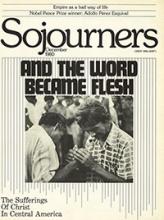The year and a half since the victorious revolution in Nicaragua has brought great strides in the reconstruction of the country as well as a successful literacy campaign directed toward all sectors of the population, which reduced the national average illiteracy rate from 50 per cent to 13 per cent. The continuing work is marked by the same spirit of mercy and reconciliation that led Tomas Borge, a Sandinista who had been tortured by Somoza's National Guard, to return to his torturer and say, "I have come to get my revenge; my revenge is that I forgive you."
The following is excerpted from the personal journal of Peter Hinde, a Carmelite priest and Sojourners correspondent who has spent more than eight years in Latin America.--The Editors
The Victory
July 19,1979: Church bells are ringing out the news to the refugees: "Peace in Nicaragua!"
Dictator Anastasio Somoza fled two days ago to Miami, ending a 45-year Somoza dynasty in Nicaragua. Today his National Guard High Command fled to Honduras in 25 planes with 186 people--officers and their families.
News of bands of National Guard retreating through the border area, taking reprisals as they go, unsettle people here in Triunfo, Honduras, just three miles from the border. But everyone is up with life and song. Radio Nacional of Nicaragua has been taken over for liberation messages and songs.
In the midst of ringing church bells, a group of young Nicaraguans came bounding into the parish to embrace everyone in sight, calling for a march through the town.
My own spirit has quickened these days. The psalm for Lauds, the morning prayer of the church, resonates with all that is taking place around us:
Read the Full Article

